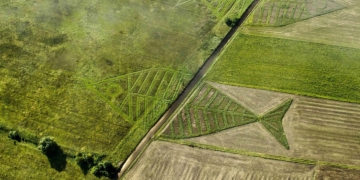Built in the city named after Alexander the Great, this lighthouse has illuminated the way for ships entering the Egyptian port for over a thousand years.
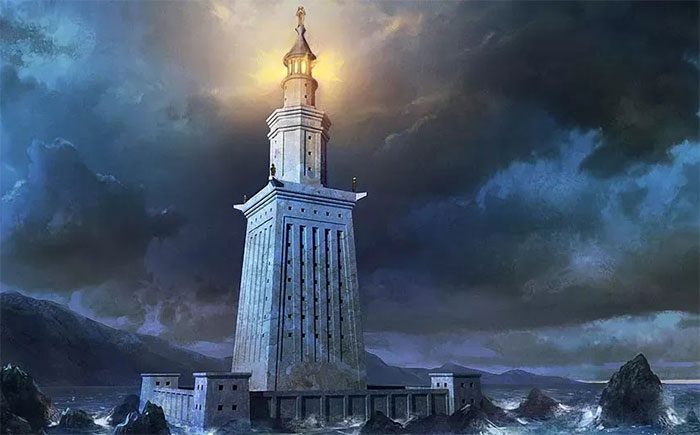
The Lighthouse of Alexandria.
It is the Lighthouse of Alexandria, considered one of the seven wonders of the ancient world. This remarkable lighthouse, along with the city of Alexandria, is closely linked to Alexander the Great, one of the most outstanding generals in history.
Alexander the Great (356 BC – 323 BC) was the son of King Philip II of Macedonia and his fourth wife, Princess Olympias of Epirus. He is regarded as an emperor, an undefeated military genius, who left many political marks and valuable military lessons for future generations.
By the age of 20, Alexander the Great had achieved numerous glorious victories, becoming the ruler of the Macedonian Empire and dominating vast territories. Over the next 10 years, this military genius commanded his army, conquering vast lands such as Greece and Egypt, contributing to the creation of a vast and great empire.
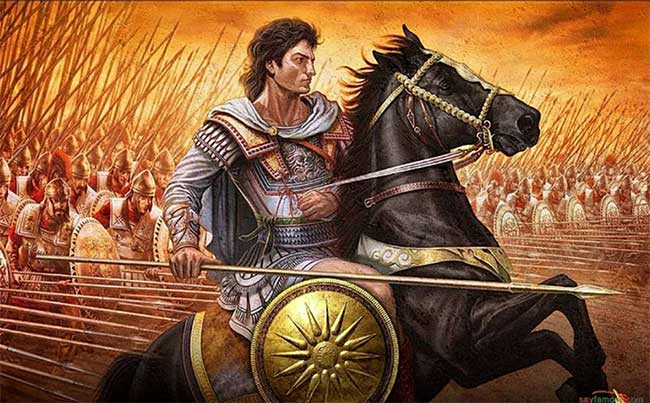
Alexander the Great is considered one of the most outstanding military geniuses in history. (Image: Wp)
In 331 BC, while passing through northern Egypt, Alexander the Great founded a city named after himself. In less than three years, after beginning his campaign to conquer Persia, Alexander had gained control over the eastern coastal region of the Mediterranean.
In the Nile Delta, the king of Macedonia decided to establish a port to secure control over his maritime territories and to create a trade center to replace the city of Tyre in Phoenicia, which he had just flattened.
Alexander quickly found a perfect location for the new city. It was a strip of land connected to the Nile River via its western branch and protected by Lake Maryut to the south.
In his biography of Alexander the Great, the Greek historian Plutarch recorded a troubling event during the city planning process. According to him, while observing the design layout of the city’s roads and canals, Dinocrates, Alexander’s architect, used flour as a substitute when he ran out of chalk.
However, just after Dinocrates completed his work, a flock of birds appeared, darkening the sky and devouring all the flour. Initially, Alexander was worried, thinking it was an ominous sign, but the soothsayers told him it was a sign that the new city would provide sustenance for the whole world.
The City of Alexandria Needs a Lighthouse
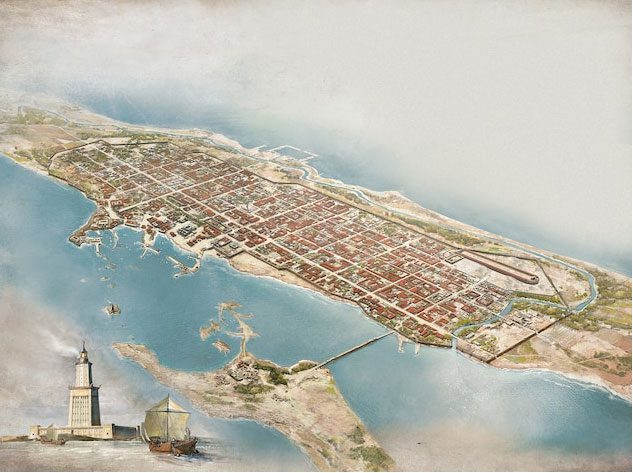
The location of Alexandria, home to the famous lighthouse in the ancient world. (Image: NatGeo)
The city of Alexandria has a shape resembling a perfect rectangle between the sea and Lake Maryut. Contemporary travelers compared this city to a chlamys, a cloak of ancient Greeks.
Alexandria received its water supply through a canal connected to the Canopic branch of the Nile Delta. In fact, the drainage system and wide avenues of Alexandria were quite rare in the eastern Mediterranean. The city was divided into five districts, with nearly a quarter of the expanded area belonging to the royal palaces and gardens.
In Alexandria, the deep port was suitable for large-draft ships. In fact, the port was protected by islands from dangerous winds coming from the north.
However, without a compass or navigational tools, it was difficult to find the way by observing the coastline. Moreover, the surrounding area of the Nile Delta had no mountains or cliffs, and the coastline was just marshes and deserts stretching endlessly. Meanwhile, the land was so low that it seemed to be hidden behind the sea.
Additionally, there was another potential natural danger: a vast strip of land that was mostly submerged, but invisible to those unfamiliar with the coastal waters.
In reality, many sailors found that they discovered this strip of land just as they thought they were about to dock, but the consequence was that their ships would run aground on this strip. Particularly, the final barrier was the submerged rocks stretching in front of Alexandria, which could pose deadly dangers to sailors and ships approaching if the winds were unfavorable. Therefore, the port of Alexandria needed a lighthouse, but not just any lighthouse would suffice.
Alexander the Great’s Dream and the Remarkable Lighthouse
The location of the lighthouse in Alexandria was carefully chosen. Off the coast of Alexandria was a small island called Pharos. This place was honored in Greek culture because at Pharos, Menelaus, one of the Greek warriors in the epics Iliad and Odyssey, was stranded while returning from the Trojan War.
Historian Plutarch stated that the poet Homer, the author of the Iliad and Odyssey, appeared in Alexander the Great’s dreams to speak about the island of Pharos: “Now, off the coast of Egypt, there is an island rising and falling in the waves of the ocean. They call it Pharos… There is a charming little harbor there.”
When Alexander the Great woke up, he began searching for the island, and upon finding it, he remarked that Homer was not only an admirable poet but also a very wise architect.
The chosen site for constructing the lighthouse was at the western end of Pharos. The lighthouse itself was an architectural marvel. It was constructed from the island of Pharos. From that point, pharos means “lighthouse” in Greek.
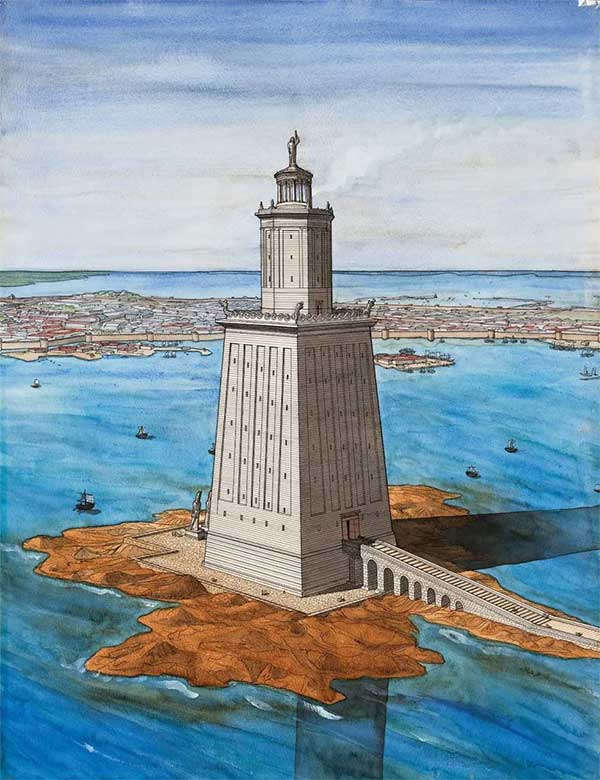
A painting of the Lighthouse in Alexandria. (Image: NatGeo)
The initiator of the lighthouse’s construction was Ptolemy I Soter, a general under Alexander the Great, who was also a Macedonian nobleman who gained control of Egypt after Alexander’s mysterious death in 323 BC.
The lighthouse project was completed during the reign of his son, Ptolemy II Philadelphus.
The Lighthouse of Alexandria looked magnificent, with construction costs amounting to 800 talents (equivalent to about 23 tons of silver), consuming about 1/10 of the entire royal treasury.
This remarkable lighthouse fulfilled its duties perfectly. Specifically, during the day, sailors could use the lighthouse for navigation. At night, they could also safely locate the harbor thanks to the light emitted from the lighthouse.
Standing over 90 meters tall, sailors could see the lighthouse from nearly 55 kilometers away.
Notably, the flame burning at the top of the lighthouse was so bright that it could be mistaken for a star in the dark night. Even the smoke rising from it allowed sailors to see the lighthouse from very far away during the day. At that time, due to the scarcity of wood in Egypt, many scholars believed that ancient people used oil or papyrus to light the lighthouse.
Some scholars even considered the possibility that the Lighthouse of Alexandria had an ancient foghorn. This horn would produce sound when the coast was shrouded in clouds. Arab scholars described that terrible voices emanated from the tower. However, the exact mechanism for sound signaling has yet to be determined.
The Lighthouse Renowned in the Ancient World
With its scale, height, and unique architecture, the Lighthouse of Alexandria quickly garnered admiration from many. In ancient Greece, this lighthouse symbolized the power of Alexander the Great and the Ptolemaic dynasty.
Some ancient scholars included the lighthouse in the list of the seven wonders of the ancient world.
Even Roman coins from Alexandria dating back to 81 and 192 featured images of this lighthouse. Despite its immense fame and becoming a proud symbol, the lighthouse ultimately could not withstand the ravages of time.
According to historical records, in the 1st century BC, Cleopatra VII, the last queen of the Ptolemaic dynasty, ordered the first restoration of the lighthouse.
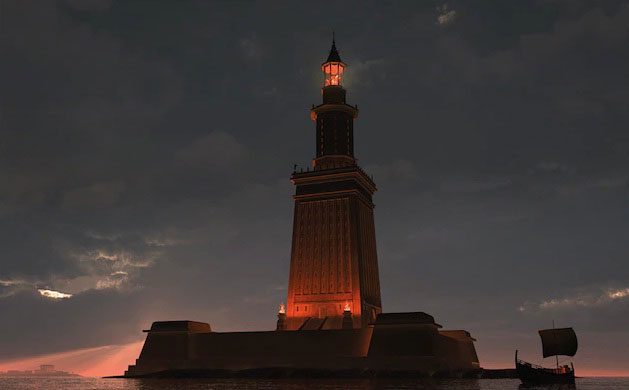
The Lighthouse in the city of Alexandria is considered one of the seven wonders of the ancient world. (Image: NatGeo)
Nearly 700 years later, when the Arabs conquered Egypt, the lighthouse in Alexandria still stood tall. However, gradually, the impact of earthquakes that shook Egypt during the Middle Ages led to the destruction of the lighthouse.
By the 14th century, Ibn Battutah, a famous Moroccan explorer, expressed his sorrow over the unfortunate state of the lighthouse.
In 1477, when the lighthouse in Alexandria had become a pile of ruins, a Mamluk king ordered the use of the remaining parts of the tower to build Qaitbay Citadel, one of the most important defensive fortifications along the Mediterranean coast, which still exists to this day.




















































